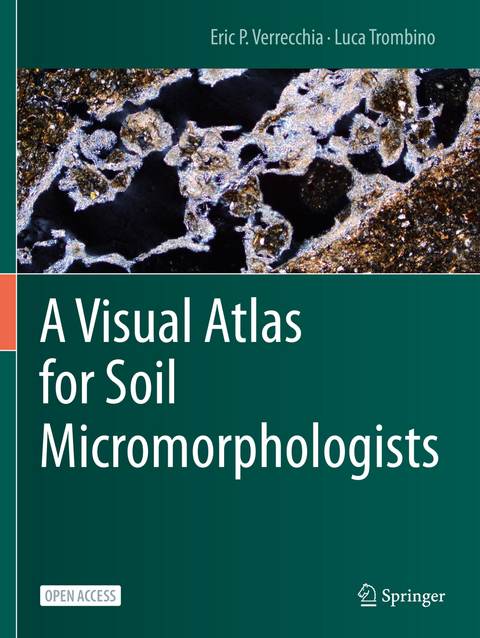
A Visual Atlas for Soil Micromorphologists
Springer International Publishing (Verlag)
978-3-030-67808-1 (ISBN)
Dr. Eric P. Verrecchia is a full professor of Biogeosciences at the Institute of Earth Surface Processes, University of Lausanne (Switzerland). He specializes in geopedology and biogeochemistry of the terrestrial carbon and calcium cycles. Awarded with a Marie-Curie-Fellowship in 1994-95, he joined Prof. G. Stoops laboratory of soil micromorphology in Gent (Belgium), where he was introduced to the microscopic approach of soils. Since then, he as been teaching and applying this technique, by coupling it with biogeochemical methods, to soils from the tropics and the temperate zone, particularly in carbonate-rich environments.
Dr. Luca Trombino is associate professor at the University of Milan, Earth Sciences Department. His main research topics are in the field of geopedology, paleopedology, soil and archaeological deposits, where he extensively uses thin section micromorphology, coupled to sedimentology, geoarchaeology and Quaternary geology methods. He started to practice soil micromorphology in 1994 when he attended the courses by G. Stoops at the University of Gent (Belgium), and at present, is teaching Micropedology to the students of the M.Sc. in BioGeoSciences at the University of Milan.
Chapter 1. The multiscalar nature of soils.- Chapter 2. History of micromorphology.- Chapter 3. Observation and sampling of soils.- Chapter 4. How to make thin sections.- Chapter 5.The polarised light microscope.- Chapter 6. Other techniques of observation.- Chapter 7. Electron and energy imaging.- Chapter 8. Colours of minerals.- Chapter 9. The micromorphological approach.- Chapter 10. Concept of fabric.- Chapter 11. Multiscalar approach to fabric.- Chapter 12. Basic distribution patterns.- Chapter 13. c/f related distributions I.- Chapter 14. c/f related distributions II.- Chapter 15. Aggregates and aggregation.- Chapter 16. Degree of separation and accommodation of aggregates.- Chapter 17. The nature of voids.- Chapter 18. Morphology of voids I.- Chapter 19. The morphology of voids II.- Chapter 20. Microstructure I.- Chapter 21. Microstructure II.- Chapter 22. Mineral and organic constituents.- Chapter 23. Particle size and sorting.- Chapter 24. Shape of grains: equidimensionality.- Chapter 25. Shape of grains: roundness and sphericity.- Chapter 26. Basalt, granite, and gabbro.- Chapter 27. Schist, gneiss, and amphibolite.- Chapter 28. Quartzite and marble.- Chapter 29. Calcium-bearing sedimentary rocks.- Chapter 30. Sand and sandstone.- Chapter 31. Mineral grains in the soil I: quartz and chalcedony.- Chapter 32. Mineral grains in the soil II: feldspar and mica.- Chapter 33. Mineral grains in the soil III: inosilicates and nesosilicates.- Chapter 34. Mineral grains in the soil IV: carbonates.- Chapter 35. Mineral grains in the soil V: chlorides and sulfates.- Chapter 36. Biominerals I.- Chapter 37. Biominerals II.- Chapter 38. Biominerals III.- Chapter 39. Anthropogenic features I.- Chapter 40. Anthropogenic features II.- Chapter 41. Organic matter I.- Chapter 42. Organic matter II.- Chapter 43. Humus.- Chapter 44. Micromass.- Chapter 45. B-fabric I.- Chapter 46. B-fabric II.- Chapter 47. Imprints of pedogenesis.- Chapter 48. Iron- and manganese-bearing nodules.- Chapter 49. Carbonate nodules.- Chapter 50. Polygenetic nodules.- Chapter 51. Nodules: morphology and border shape.- Chapter 52. Nodules: orthic, anorthic, disorthic.- Chapter 53. Crystals and crystal intergrowths.- Chapter 54. Impregnations.- Chapter 55. Depletions.- Chapter 56. Coatings with clays I.- Chapter 57. Coatings with clays II.- Chapter 58. Micropans, coarse coatings, cappings, and crusts.- Chapter 59. Hypocoatings and quasicoatings: amorphous.- Chapter 60. Coatings and hypocoatings: crystalline.- Chapter 61. Mineral infillings.- Chapter 62. Mineral infillings of biological origin.- Chapter 63. Pedoturbations.- Chapter 64. Faecal pellets.- Chapter 65. Dung and vertebrate excrements.- Chapter 66. Composite pedogenic features.- Chapter 67. Uncommon features.- Chapter 68. Pedofeatures and soil processes.- Chapter 69. Clay dynamics I - Translocation.- Chapter 70. Clay dynamics II - Swelling.- Chapter 71. Water dynamics..- Chapter 72. Carbonate and gypsum dynamics.- Chapter73. Processes involving iron oxyhydroxides.- Chapter 74. Biogeochemical processes I.- Chapter 75. Biogeochemical processes II.- Chapter 76. The future of soil micromorphology.- Chapter 77. Beyond the two dimensions.- Chapter 78. The prospect of chemical imaging
| Erscheinungsdatum | 14.08.2021 |
|---|---|
| Zusatzinfo | XIX, 177 p. 82 illus., 81 illus. in color. |
| Verlagsort | Cham |
| Sprache | englisch |
| Maße | 210 x 279 mm |
| Gewicht | 504 g |
| Themenwelt | Naturwissenschaften ► Biologie ► Ökologie / Naturschutz |
| Naturwissenschaften ► Geowissenschaften ► Geografie / Kartografie | |
| Naturwissenschaften ► Geowissenschaften ► Geologie | |
| Naturwissenschaften ► Geowissenschaften ► Mineralogie / Paläontologie | |
| Weitere Fachgebiete ► Land- / Forstwirtschaft / Fischerei | |
| Schlagworte | biominerals • Fabric • Microstructures • open access • Pedogenic features • Soil fragments • Soil micromorphology |
| ISBN-10 | 3-030-67808-3 / 3030678083 |
| ISBN-13 | 978-3-030-67808-1 / 9783030678081 |
| Zustand | Neuware |
| Informationen gemäß Produktsicherheitsverordnung (GPSR) | |
| Haben Sie eine Frage zum Produkt? |
aus dem Bereich


